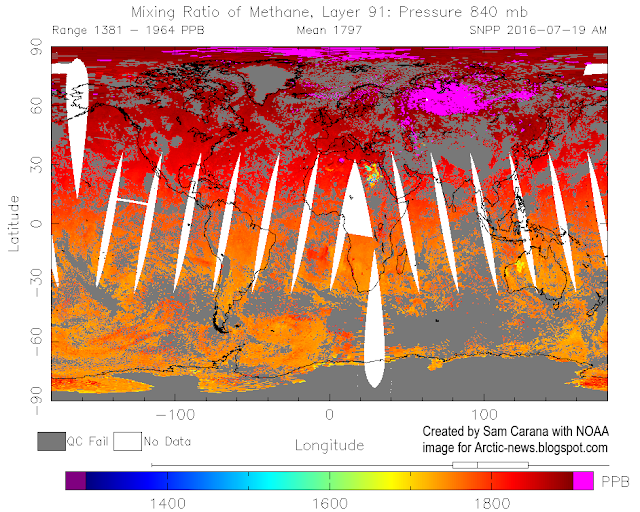Above image was created with USGS (United States Geological Survey) content. The image shows the epicenter of the quake (gold star). The earthquake hit Barrow Strait on January 8, 2017 at 23:47:12 (UTC), at 74.320°N - 92.305°W and at a depth of 18.9 km.
Another earthquake hit Barrow Strait on January 9, 2017, this time with a magnitude of 5.2 on the Richter scale, within a day of the earlier M5.8 quake (both in orange on map below). These two earthquakes are among the largest quakes to hit the area in the past five years (map area shows all M1+ quakes since January 9, 2012).
These earthquakes are important, given their magnitude and given that they hit an area without large faultlines (though earthquakes are not uncommon here, also see this discussion). Importantly, these earthquakes occurred in an area prone to glacial isostatic adjustment, as illustrated by the image below.
Glacial isostatic adjustment as a phenomenon typically takes place over relatively long periods. Yet, extreme weather events can trigger earthquakes in areas that are already on the edge.
The extreme weather situation is depicted by the combination image below.
Similar to the M4.6 earthquake that hit Baffin Island on February 12, 2015, this earthquake occurred at a time when surface temperature anomalies over parts of North America and Greenland were at the bottom end of the scale. At the same time, temperature anomalies over the Arctic Ocean are at the top end of the scale, as illustrated by the left panel in above image. The right panel in above image shows pressure differences reaching the top and bottom ends of the scale.
Earthquakes in the Arctic Ocean are dangerous as they can destabilize methane hydrates. Huge amounts of methane are present in sediments under the Arctic Ocean in the form of free gas and hydrates. Earthquakes can send out strong tremors through the sediment and shockwaves through the water, which can trigger further earthquakes, landslides and destabilization of methane hydrates. The situation is especially dangerous when combined with extreme weather events that can cause cracks and movement in sediments.
Above map, from an earlier post, shows the location of fault lines on the Northern Hemisphere.
The combination image below shows methane levels on January 9, 2017, am, at two different altitudes.
 |
| [ click on images to enlarge ] |
As temperatures in the Arctic Ocean keep rising, the jet streams and polar vortex are changing their shapes. The North Polar Jet Stream becomes more wavy, and this makes that more extreme weather events can happen such as the events described above.
The situation is dire and calls for comprehensive and effective action, as described at the Climate Plan.
Links
• Climate Plan
http://arctic-news.blogspot.com/p/climateplan.html
• Seafloor Methane
http://arctic-news.blogspot.com/2016/12/seafloor-methane.html
• High Methane Levels Follow Earthquake in Arctic Ocean
http://arctic-news.blogspot.com/2016/07/high-methane-levels-follow-earthquake-in-arctic-ocean.html
• Something had to give - Baffin Island hit by M4.6 earthquake
http://arctic-news.blogspot.com/2015/02/something-had-to-give-baffin-island-hit-by-m4.6-earthquake.html
• Ring Of Ice
http://arctic-news.blogspot.com/2014/08/ring-of-ice.html
• High Methane Levels over Laptev Sea
http://arctic-news.blogspot.com/2013/10/high-methane-levels-over-laptev-sea.html
• Methane Release caused by Earthquakes
http://arctic-news.blogspot.com/2013/09/methane-release-caused-by-earthquakes.html
• Sea of Okhotsk
http://methane-hydrates.blogspot.com/2013/06/sea-of-okhotsk.html

































